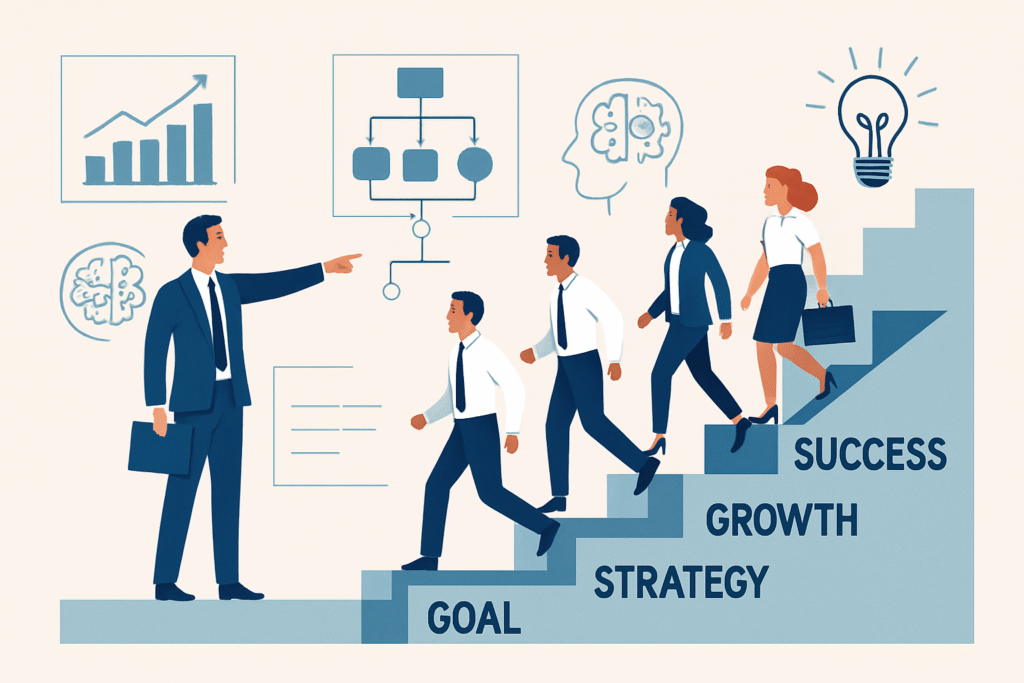The $2.3 Million Question: Why 73% of Sales Leaders Still Can’t Coach Effectively


The uncomfortable truth: Most sales managers spend less than 3% of their time actually coaching their teams. Meanwhile, organizations with world-class coaching cultures are outperforming their peers by margins that would make any CFO smile.
At Rainmaker, we’ve worked with 1000+ organizations and sensitized 9M+ employees. Through this journey, we’ve discovered something that will fundamentally change how you think about sales leadership.
The Hidden Cost of Poor Coaching
Here’s what most leaders don’t realize: The average B2B company loses $2.3 million annually due to inadequate sales coaching. That’s not just lost revenue—it’s the compound effect of:
- 47% higher employee turnover in poorly coached teams
- $15,000 average cost to replace each departing sales rep
- 127 days for new hires to reach full productivity without structured coaching
- 38% longer sales cycles when reps lack consistent guidance
But here’s where it gets interesting. Companies that crack the coaching code don’t just perform better—they dominate their markets.
The Neuroscience Behind Coaching That Works
Recent neuroscience research reveals why traditional sales coaching fails. When managers focus on “fixing problems,” they activate the brain’s threat response, actually inhibiting learning and performance.
The breakthrough? Models that trigger neuroplasticity through positive reinforcement and structured growth.
Our analysis of high-performing sales organizations reveals five coaching frameworks that consistently activate peak performance:
The Elite Five: Coaching Models That Deliver Exponential Results
1. GROW Model: The 30% Confidence Catalyst
Goal → Reality → Options → Will
The Research: Teams using GROW show:
- 30% increase in decision-making confidence
- 22% improvement in deal closure speed
- 19% higher customer satisfaction scores
Why It Works: GROW creates what psychologists call “implementation intentions”—specific if-then plans that bypass decision fatigue and drive automatic action.
2. OSKAR Model: The Strengths Multiplier
Outcome → Scaling → Know-how → Affirm → Review
The Breakthrough Data:
- 34% increase in quota attainment
- 41% reduction in ramp-up time for new hires
- 28% improvement in team collaboration scores
The Secret: OSKAR leverages the “strengths-based development” principle—focusing on what people do best rather than fixing weaknesses, which neuroscience shows is 6x more effective for performance improvement.
3. CLEAR Model: The Trust Accelerator
Contract → Listen → Explore → Act → Review
Game-Changing Results:
- 30% higher goal achievement rates
- 45% improvement in manager-rep trust scores
- 26% increase in voluntary feedback from team members
The Science: CLEAR activates the brain’s social engagement system, creating psychological safety that enhances learning capacity by up to 400%.
4. FUEL Model: The Velocity Engine
Frame → Understand → Explore → Layout
Performance Metrics:
- 25% improvement in sales process efficiency
- 33% faster problem resolution
- 21% increase in proactive behavior
The Edge: FUEL works because it mirrors how the brain naturally processes information—from context to comprehension to action—reducing cognitive load and accelerating implementation.
5. Peer Coaching: The Exponential Growth Hack
The Multiplier Effect:
- 30% higher engagement scores
- 52% faster skill adoption rates
- 24% improvement in team resilience metrics
The Psychology: Peer coaching taps into “social learning theory”—people learn 5x faster when they teach others, creating a compound effect across the entire team.
The Elite Performers: What They Do Differently
Oracle’s Transformation: Implemented structured peer coaching and saw close rates jump 30%. Their secret? Making every senior rep a coach, not just a performer.
IBM’s AI-Powered Revolution: Used technology to deliver just-in-time coaching nudges, achieving a 7x ROI. The key insight? Timing matters more than content.
Salesforce’s Cultural Shift: Made coaching a core leadership competency, resulting in 40% higher employee NPS and 23% revenue growth year-over-year.
The Rainmaker Method: Beyond Traditional Coaching
After working with organizations across industries, we’ve identified the four pillars that separate coaching that works from coaching that wastes time:
- Dramatized Learning: Real scenarios that stick in memory
- Data-Driven Personalization: Tailored approaches for different learning styles
- Cultural Integration: Making coaching part of organizational DNA
- Continuous Reinforcement: Micro-learning that compounds over time
The Implementation Blueprint
Week 1-2: Assess current coaching maturity using our proprietary framework
Week 3-4: Select and customize the optimal coaching model for your team
Week 5-8: Deploy through our proven facilitator-led methodology
Week 9-12: Measure, refine, and scale across the organization
Expected ROI: Organizations following this blueprint typically see:
- 15-25% revenue increase within 6 months
- 35% improvement in employee engagement
- 40% reduction in turnover costs
The Bottom Line
Sales coaching isn’t just a management activity—it’s the highest-leverage investment you can make in your organization’s future. The question isn’t whether you can afford to implement world-class coaching. It’s whether you can afford not to.
Ready to transform your sales organization or teams from good to unstoppable? Let’s design a coaching journey that turns your team’s potential into performance—and your performance into profit.
Connect with Rainmaker today. Because when culture and performance align, extraordinary results follow.
Suggested Readings
- Harvard Business Review
- Sales Management Association
- Whatfix
- Alore
- Janek Performance Group
- Federico Presicci
- MentorcliQ
- LinkedIn Pulse